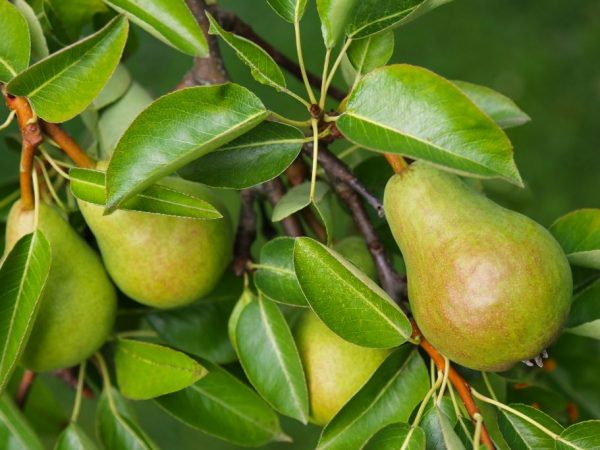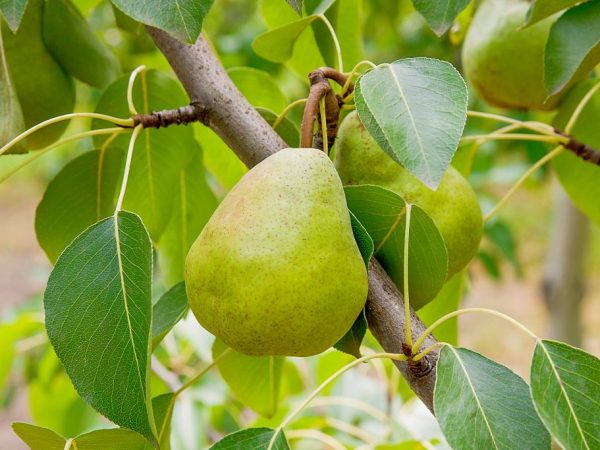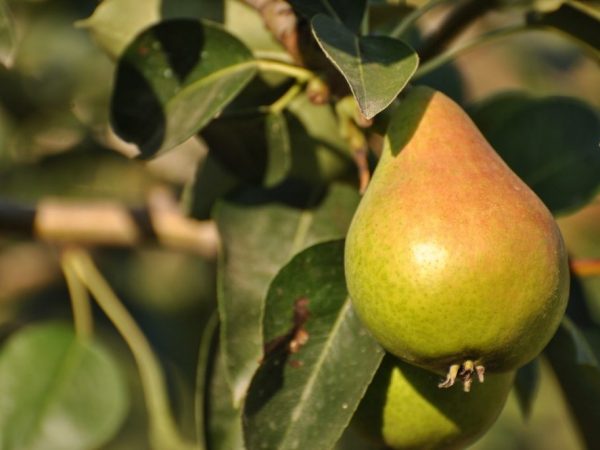Description of Veles pear
Veles pear is one of the most common varieties of fruit trees. Most often, this species is grown in the Moscow region. Many summer residents note the resistance of the variety to frequent diseases. It is also characterized by excellent taste and aroma.

Description of Veles pear
General information about the variety
To get a new variety of fruit tree called Velesa, breeders had to cross Venus and Beauty of the Forest. Breeding development has been going on for many years, starting in 1985. Only in 2001, the Veles pear variety was entered into the State Register of the Russian Federation.
Cultivation of this species is possible in any part of the country, because it is resistant to frost and does not die even under the influence of low temperatures.
Description of the plant
At a young age, the tree has a large spreading crown. Every year the plant takes on a shape that looks more like a wide pyramid. According to the description, the height of an adult tree is no more than 4 m.
The main trunk is strong and powerful in structure, has a curved shape. The rings are evenly distributed on all branches. The color of the lateral shoots is brown. The color of the leaves is dark green. Their surface is smooth, but there is a small patch of pollen at the ends.
Full fruiting occurs at the end of August. Harvesting is recommended to be carried out 2 times per season. For the first time, in the middle of August, all the overall fruits are harvested. The second time, in the middle of September, the remains of the harvest.
Features of the fetus
The Veles pear is characterized by smooth and smooth pale yellow fruits. They are symmetrical and have no ribs.
On average, the weight of the fruit is 200 g. Yield indicators are about 10 kg of selected high quality products from 1 tree. The pulp is characterized by juiciness and excellent taste. The sugar level is around 17%. According to the description, the Veles pear belongs to the universal varieties. It can be eaten fresh or used for preparations for the winter.
Pollination
Although Veles pears are self-fertile, it is better to plant other varieties with them. This is necessary to create conditions for pollination.
Ideal pollinators for this species are 3 types of pears.
- Severyanka. She has good indicators of taste and commercial quality. The tree bears fruit in the summer. Despite this, it is not exposed to low temperatures.
- Leningradskaya. Belongs to mid-season crops, begins to bear fruit in early autumn.
- Rogneda. Autumn type of pear, which has excellent indicators of the immune system, in relation to fruit rot and scab.
Cultivation of culture

The tree needs sunshine
Planting a Veles pear involves not only the correct placement of the seedling. It is also important to consider such features as the choice of planting material and the place for planting.
If you choose the wrong place for growing or buy a low-quality seedling, you will not be able to achieve the harvest. If you follow all the rules below, you can get a really high-quality tree that can bear fruit for more than a dozen years.
Rules for choosing a seedling
Choose seedlings that are a maximum of 2 years old. The height of the seedling should be at least 50 cm. At the same time, be sure to pay attention to an even trunk without the presence of damaged areas. The number of side branches should be minimal. There are also some basic rules for the root system.
- The roots should not be dry, otherwise they will not take root in the ground.
- Their length should be more than 25 cm. This condition is necessary so that the tree can catch on the soil and not be damaged by strong gusts of wind.
- There should be no damage, otherwise fruiting will be significantly reduced.
Preparing the landing site
A young tree is a thermophilic plant, therefore, planting should be carried out on an area near the house in a place that is always illuminated by a lot of sunlight: this allows the tree to be resistant to windy weather and severe frosts. The soil should contain a large amount of black soil or be sandy. If you choose clayey areas, then the development will be long, and fruiting will not occur.
Soil preparation is carried out in the autumn. Initially, a hole is dug 50 x 100 cm in size. A small amount of organic matter (humus or peat) is poured onto the bottom, then the bottom is loosened so that fertilizers can better penetrate into the ground.
Planting
There are several planting rules. If you follow all the recommendations, the pear of the Veles variety will be much easier to develop:
- A support in the form of a peg is pre-installed near the hole. This is done so that the planted plant can be tied up, otherwise the trunk will be deformed.
- The neck of the root part is placed on the surface of the soil. If you dig it into the ground, the development of the roots will stop.
- The earth is poured gradually. After applying a small amount of soil, the seedling is watered and pulled out a little. This is necessary to evenly distribute the soil in the roots.
- After planting, a small side area is created around the tree and 2 buckets of water are poured into the resulting hole.
- They start mulching the soil. It is carried out using sawdust and a small amount of peat.
Care rules

Proper care allows you to get a good harvest
In order for the Veles pear to bear fruit well, it is necessary to provide it with high-quality and complete care.
Watering
At first, a young seedling is watered as often as possible. Watering interval is every 3 days. Each tree should have at least 2 buckets (10 liters) of warm water. The plant is watered in the morning or evening: the sun's rays evaporate moisture, which leads to root rot. Mature trees (from the age of 1 year) are watered no more than once every 90 days. Frequent watering leads to the formation of plaque on the roots, and the plant dies.
Pruning
On a young Veles pear, all branches are cut and only 1/3 of them are removed. This is necessary for the correct formation of the crown. Such actions are best carried out in the spring, so that the remaining areas receive more nutrients. Mature trees should only be pruned when their branches are close to the ground or have disease-damaged areas.
Top dressing
Crop care also includes fertilization. Top dressing includes organic and mineral substances. In the spring, when flowering is just beginning, root feeding is carried out using nitrate or urea. The solution is prepared according to the principle of 50 mg of a substance per 10 liters of water. At least 5 liters of solution are poured into each bush. In the summer, especially at the beginning of July, organic matter is used in the form of manure. For 20 liters of water, take 1 liter of manure. In 1 sq. m pour in at least 5 liters of the substance.
In autumn, it is advisable to use both mineral and organic substances. In the first case, 2 tbsp are bred. l. superphosphate agent in 10 liters of water and poured into the near-stem section. The second case involves the use of wood ash. 150 g of the mixture is buried under each bush to a depth of 15 cm.
Parasites and diseases
According to the description, the Veles pear is rarely affected by fungal infections. In addition to diseases, the Veles pear is exposed to parasites. When exposed to a pear mite, treatment is carried out with Nitrafen or Karbofos. The drug is diluted according to the instructions on the package.
If a pear sap appears, the pear is watered with karbofos or a solution of laundry soap (250 g per 10 l of water). Hawthorn is destroyed with dendrobacillin or lepodocide.
Chlorophos is used in the fight against silkworms. In a 10-liter bucket, 20 mg of the substance are diluted and sprayed.
Pear flower beetle is destroyed with wormwood tincture. To prepare it, you need 5 glasses of wormwood berries and 10 liters of water. The ingredients are mixed and infused for 5 hours.
Conclusion
Veles pear is rightfully considered one of the best varieties of fruit trees. Some gardeners note her demanding care, but this is justified by the excellent yield indicators.


